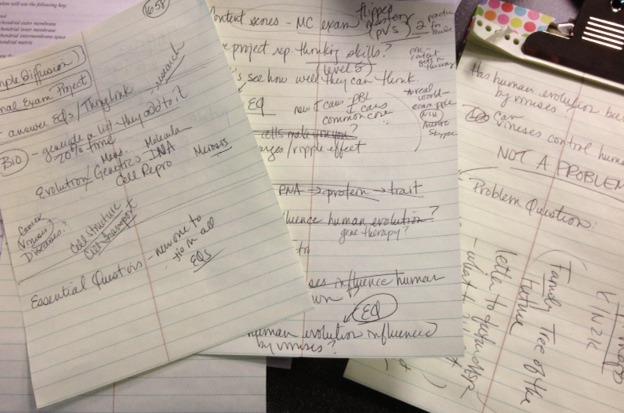We started brainstorming what we would like the final exam project to be in our Biology classes. Our collaboration is an odd dance, really, but it works for us. It starts out silently, with me thinking and writing and scratching out and complaining that I need more time to think and then me walking around somewhere trying to get ideas to shake loose and solidify in my head.
And then the talking begins. She and I bounce ideas of each other, tell each other to stop when we get confused, we clarify, we shake our heads, we disagree, we nod in agreement with ideas, and we scribble things down so our brains won't forget them, and we cross things out. Sometimes we make "ooooWEEooo" noises when we both have the same idea at the same time, and screaming often erupts when we get excited about an idea we have ("FAMILY TREES OF THE FUTURE! THAT'S IT!"). And then we scribble some more.
 Our collaboration doesn't come prepackaged and canned. It can't be taught at a workshop. It's messy and organic. Sometimes we walk away more frustrated than productive. It's face-to-face, no technology involved. Sure, we use technology to collaborate on web pages and documents, but only after the collaborative nuttiness has ensued.
Our collaboration doesn't come prepackaged and canned. It can't be taught at a workshop. It's messy and organic. Sometimes we walk away more frustrated than productive. It's face-to-face, no technology involved. Sure, we use technology to collaborate on web pages and documents, but only after the collaborative nuttiness has ensued. But that's just how we collaborate. It's what we do, it's how we've learned to operate after 6 years together.
It's how we've learned to learn from each other, because true collaboration is learning.
The question that I ask myself now is this: How do I get my students to the point of true collaboration without forcing my contrived group work upon them? And further, how do I train them out of the idea that "working in groups" means sitting together but working separately to create Frankensteined products that can be easily separated if I pull them apart at the seams?
How do I get students to realize that it's the talking, not the product, that produces the most learning during collaboration? I don't know if I can in the 6 short weeks we have left. But I'm bound and determined to try.
